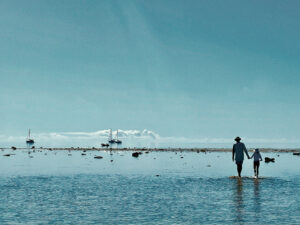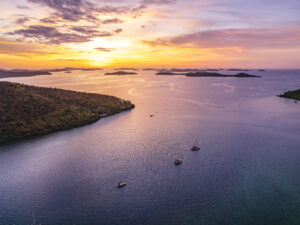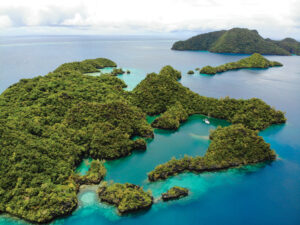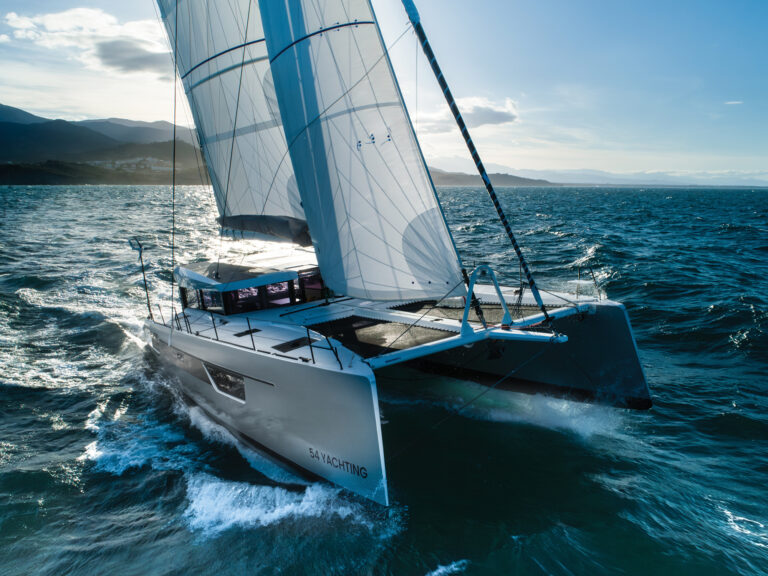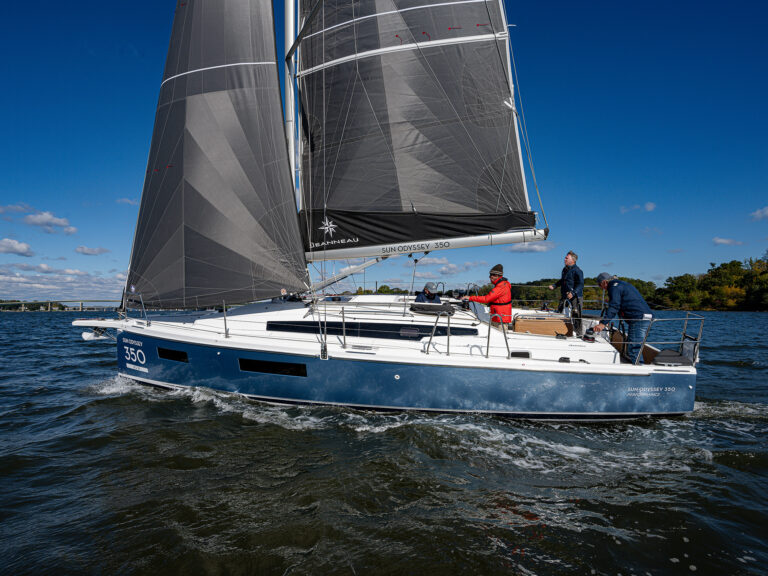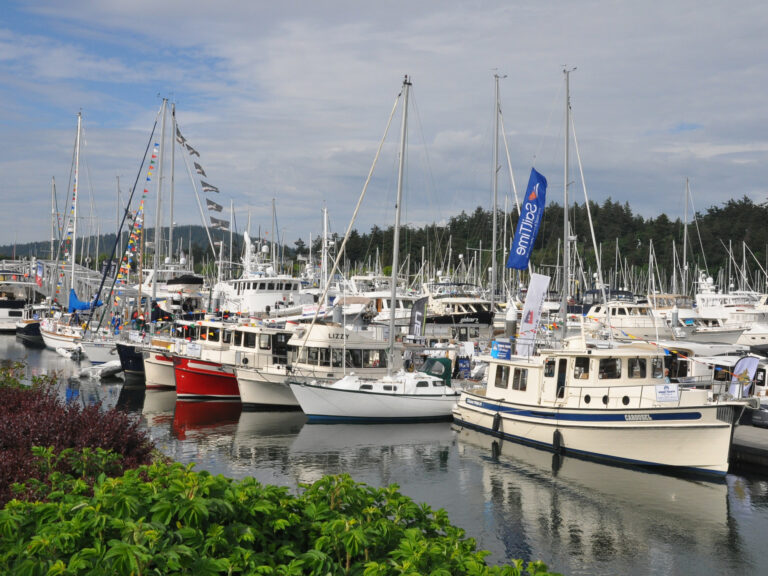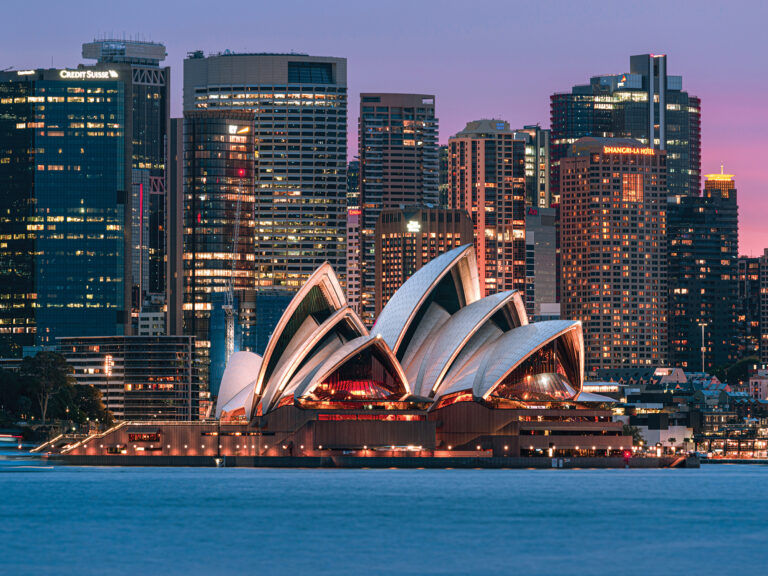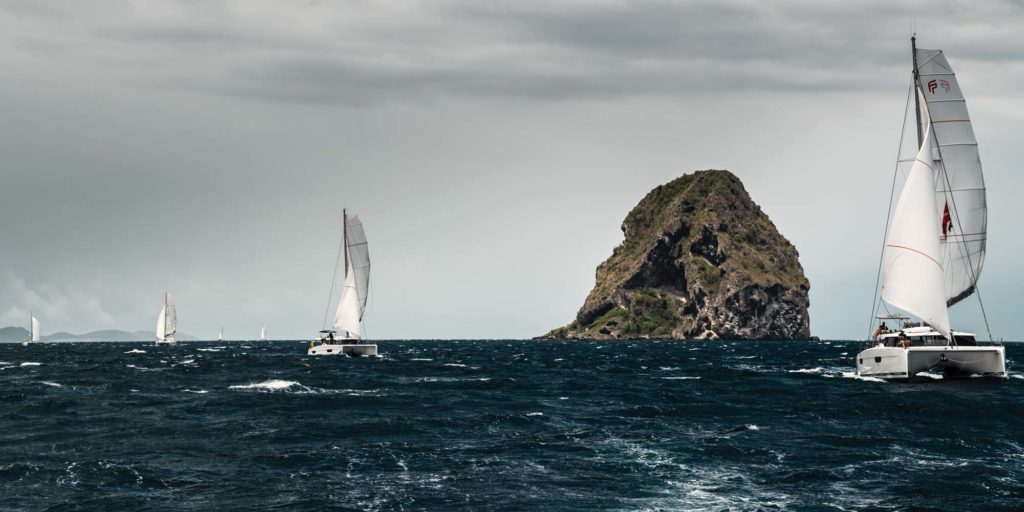
“Allez allez, allez allez,” come on, come on, a very wet fisherman in pink shorts, camo shirt and bright-yellow ball cap chanted like a drill sergeant at a parade. Alongside, a snaking line of a couple dozen equally drenched sailors grabbed a green poly line, dug heels in the sand and threw ourselves backward, pulling in a surprisingly small length with each lunge.
The rain poured down, and from time to time, the singsong chanting was accompanied by the blare of conch shells blown by fishermen farther down the beach. “Allez allez! Toot-toot!” Inch by inch, we pulled on the rough line until finally we came to the beginning of the lengthy net that was stretched across the harbor at Petite Anse d’Arlet, a small village on the southwest coast of Martinique.
Now the real work began. Our crew — French, English, Americans, Russians, you name it, all from the Fountaine Pajot catamarans anchored in the next harbor to the north — split up, half grabbing ahold of the top of the net, the others, the bottom. “Allez allez!” We pulled and pulled, fingers caught up in the webbing. Soon, feet were tangled up too as we slowly gained on the work before us and the seine net piled up on the sand.
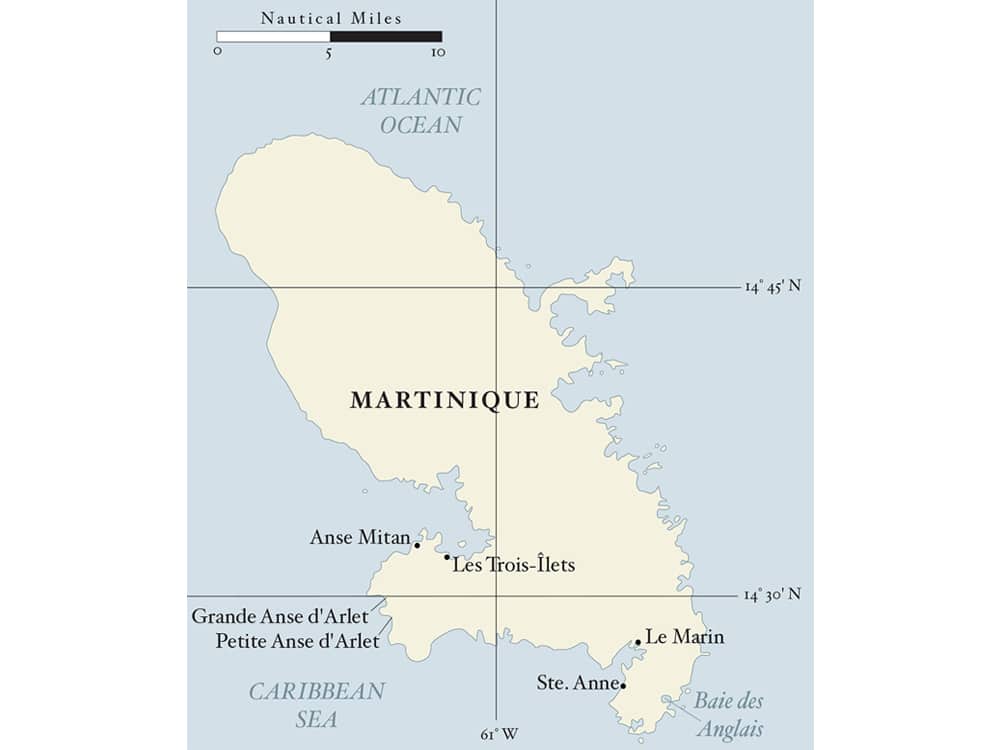
It was early, about 0630. The hour and the torrential rain kept the streets behind us empty. The beach, though, was a flurry of activity as fishermen shouted orders in French and madly blew their conchs, communicating with the men tending the net from their pangas and the divers with masks and snorkels, who swam inside it as we pulled it ashore.
At last, a half-hour or better from when we started, the end was in sight. At first, we’d pulled in only empty netting, but as it began to tighten along the water’s edge and the swimmers were now able to stand, fish roiled the water. Bins were carried down to where we worked, and the fishermen waded in to grab their catch.
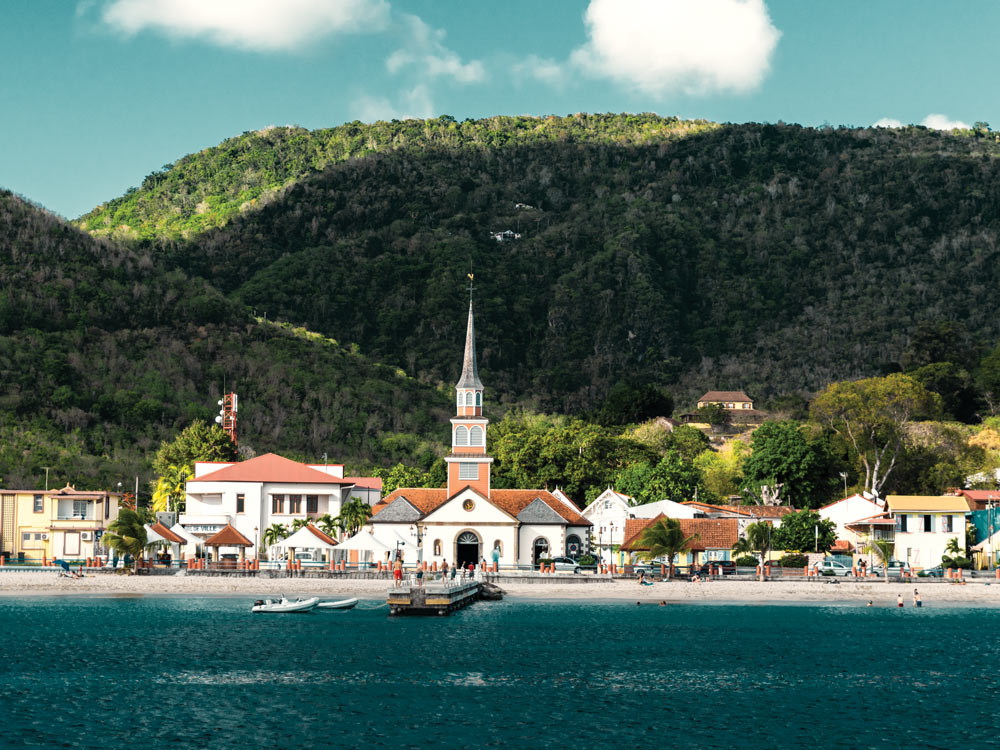
The day before, the 28 catamarans taking part in the Fountaine Pajot Owners Rendezvous had raced north from Le Marin and stopped at Petite Anse for lunch, local color and a swim with the turtles before heading off around the headland to anchor at Grande Anse for the night. This morning, the 25 or so of us who’d risen in the dark and abided by the rain to catch a bus back here for the traditional seine fishing watched as those same turtles were grabbed by the wading fishermen and tossed free. The sardines, snappers and pufferfish were not so lucky. With the net now on the sand, they were scooped up quickly. When the last flopping fish was in a tub, they were carried up the beach to where a set of scales had been set up on a nearby wall. By now, the town had woken up. There were cars and people coming and going, and the fish store, such as it was, was open for business.
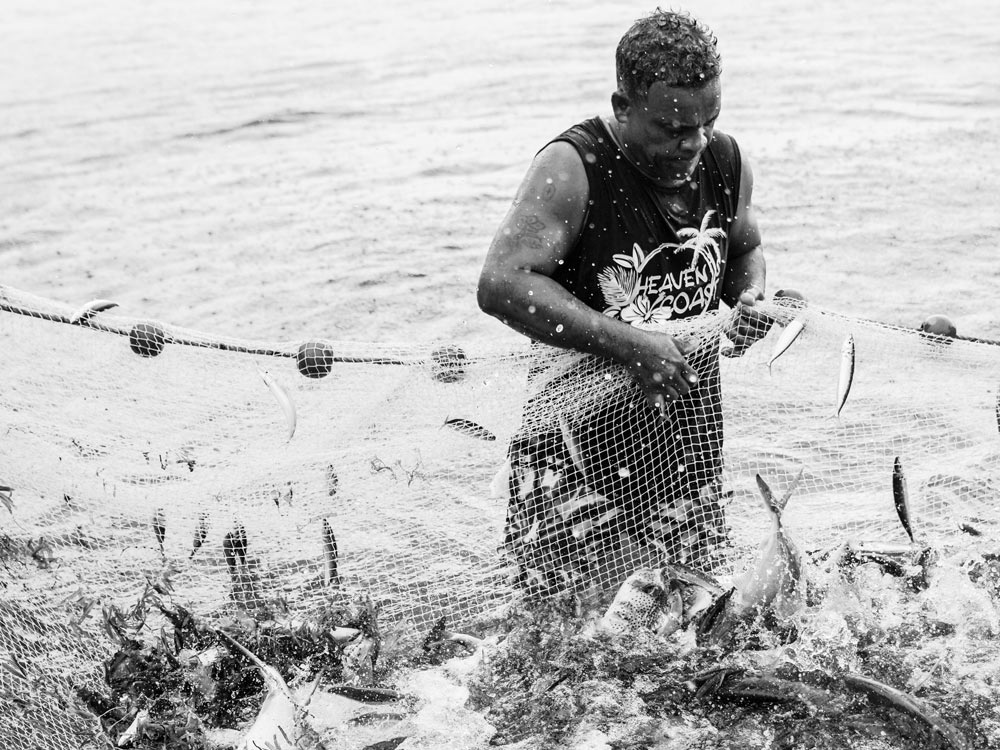
And so was the rum tasting, put on by tourism authorities and Habitation Clément, a well-known island distillery. A gregarious crowd of local officials, fishermen and sailors gathered to sample the wares. Our drill sergeant had a small glass of rum tucked neatly into the pocket of his T-shirt. The more he and his mates sipped, the more frequently they blew their conchs. Merriment, rum punch and fish cakes for breakfast — what a way to start the day!
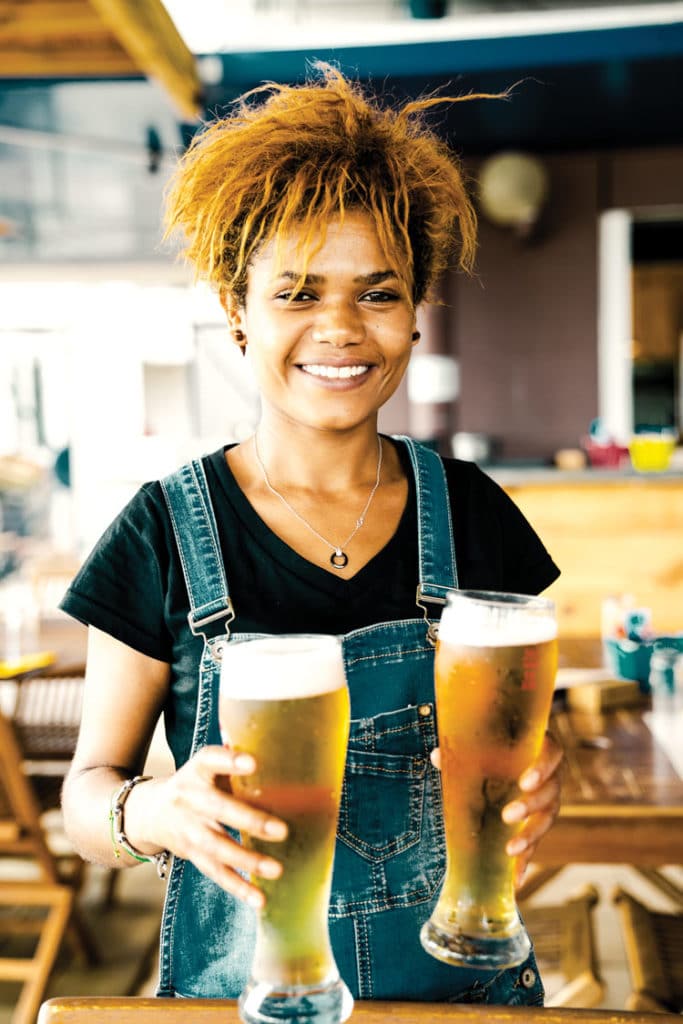
Actually, each day of this little Caribbean adventure turned out to be pretty excellent. The rally was organized by the French catamaran builder to bring its far-flung owners together for four days of sailing and parties in a location where fun was absolutely guaranteed. The fleet was a mix of privately owned vessels and charter boats, such as Guiriden, a Saona 47 we’d picked up at the Dream Yachts base in Le Marin a couple of days before the official party began. Driving our bus was CW’s advertising director, Ted Ruegg, and his wife, Heide. Calling tactics, if we needed them, was their Annapolis, Maryland, sailing pal Dave Robinson. Photographer Jon Whittle and I were on hand and determined to work and play, in equal measure.
Since we had the boat for a week, we planned it so we arrived in Le Marin a couple of days ahead of time. We flew in on Tuesday, and spent the rest of the day and Wednesday morning taking care of shoreside formalities, such as provisioning and Dream’s boat and chart briefings. Then it was time to get to work: Dutifully, we went sailing.
A Dream captain moved Guiriden from its slip and then turned the wheel over to Ted. We motored out to Pointe du Marin, where Club Med has a sprawling resort, and from there, raised sails and bore off on a close reach, heading southeast to the tip of the island. Near shore was a minefield of lobster-pot buoys, so we headed to deeper soundings before tightening up the sheets and turning east. Our destination was Baie des Anglais, a protected anchorage on Martinique’s windward coast that was well recommended at our chart briefing.
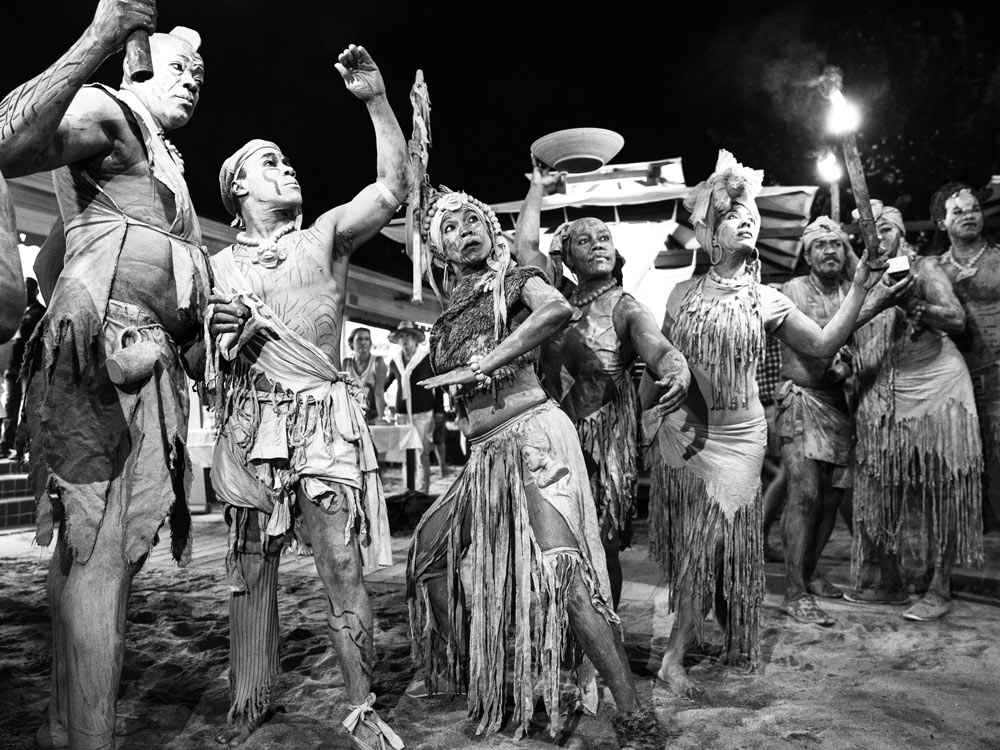
It was fine sailing, though we had a good bit of current on the nose. Eventually, our course took us closer and closer to the wind, and after a tack or two, we started the engine and just plowed into it until we reached the narrow unmarked channel leading into the bay. Surf pounded on the rocky islets on either side of us. Standing nearby Ted at the helm, I kept a close eye on the iNavX app on my phone so that we stayed in deep water. Inside, it was a millpond. Though we could see breaking waves behind us, the water was flat calm, and we were surrounded by nothing but rolling green hills and mangroves lining the shore. Better yet, we had the place all to ourselves. We swam in the brackish water, sipped and dined in fine style, and that night sat on Guiriden‘s trampoline and spotted both the Southern Cross and Polaris in the clear, dark sky.
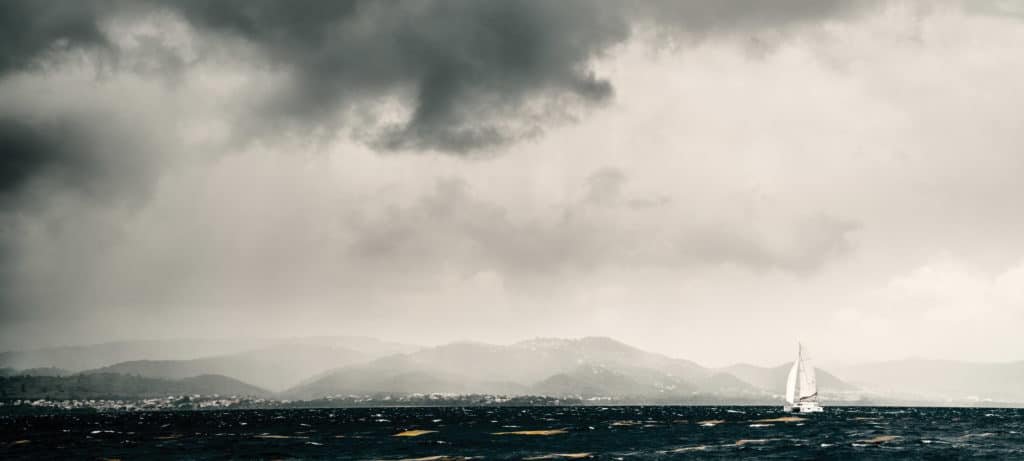
Passing squalls made for lively sailing conditions, but they were spectacular to watch as they rolled over the hills.
On Thursday, we had time for a little paddleboarding and swimming in the morning. Then, around 1100, a breezy squall passed by, taking every breath of wind with it. Instead of a lovely downwind run home, it was a motorboat ride back to Le Marin for the start of the week’s official fun.
Back at the marina where we started, rally check-in and a skippers meeting took most of the afternoon, and was followed by an open-air rum tasting and cocktail party just before sundown. That evening, we were all on our own for dinner, but the crowd tended to migrate to the casual seating and tasty dishes at L’Annexe. The place was packed and the evening lively, but with an 0800 departure and two races planned for the next morning, Team Guiriden sensibly retired (sort of) early.
The rules for the Friday-morning short around-the-buoys race, to be followed by the Cruising World Rally to les Anses d’Arlet, were simple: Leave the committee boat to starboard, the pin to port; pass between Diamond Rock and the mainland on the way north; and any boat over the starting line early would be penalized and have to buy every other boat drinks. Thank heavens they didn’t say anything about collisions.
The wind at the start of the buoy race was light and puffy. The course called for a short upwind leg, followed by a couple of reaches across the bay and back to the finish. The rally had attracted crews with vastly different sailing skills. There were Fountaine Pajot founder Jean-François Fountaine and his wife, Claire, the president of the company, both world-class sailors; then there were the folks we saw on the plane studying their learn-to-sail textbooks. The result, in the first race at least, was spirited competition at the front of the pack and a parade of boats behind. It was a pretty sight to see all those sails stretched out over a mile or two of deep blue sea.
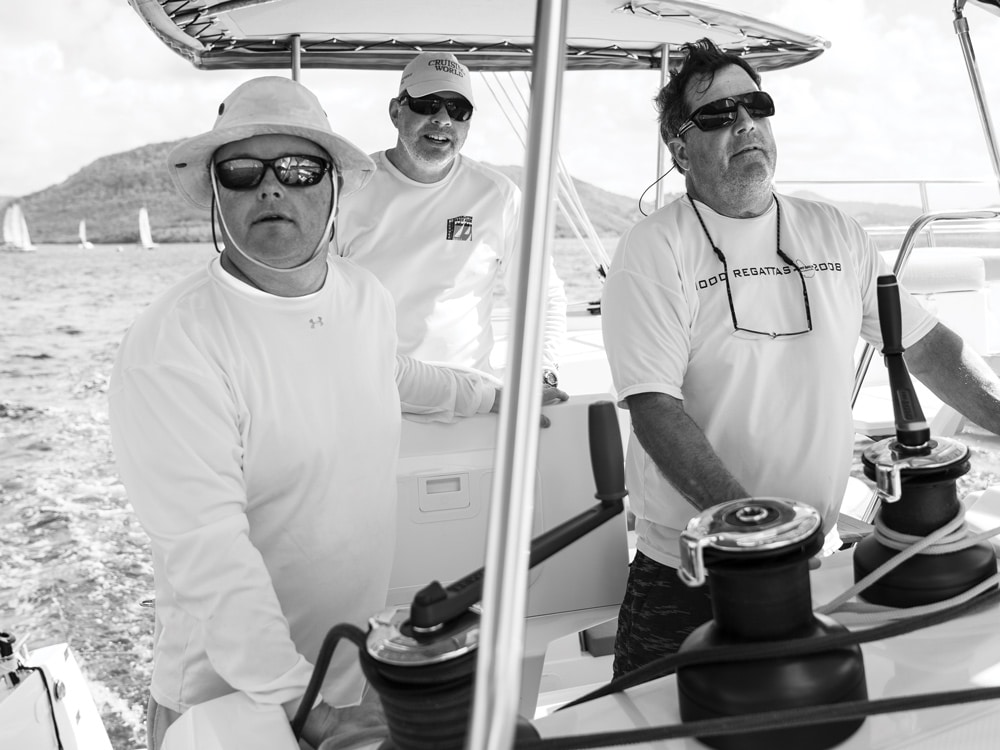
The rally proved a bit more interesting, when the breeze stalled just after the start and again just before the finish. Let’s just say new acquaintances were made on each occasion. But in between the first short windward mark and the finish line off Petite Anse d’Arlet, we had arguably some of the best sailing of the week. The wind was well aft of the beam as we bore off toward iconic Diamond Rock. On Guiriden, we winged out the genoa, leading the loaded-up sheet to a cleat amidships. For our shutterbug, Whittle, it was one of his Kodak moments when the cats neared the rock and sailed along the bold Martinique shore, clouds and their shadows dancing across the mountainous terrain inland.
In Petite Anse, we crossed the finish line, anchored and piled into the dinghy to go ashore. What a lovely little village, with its church located at the head of the pier. In a pavilion just to the left, local craftsmen and artists had set up shop. There was rum to be tasted, and traditional dancers — young women dressed in full-length white dresses with colorful calico shawls, and men in white suits with bright-red vests — swirled to lively Caribbean tunes.
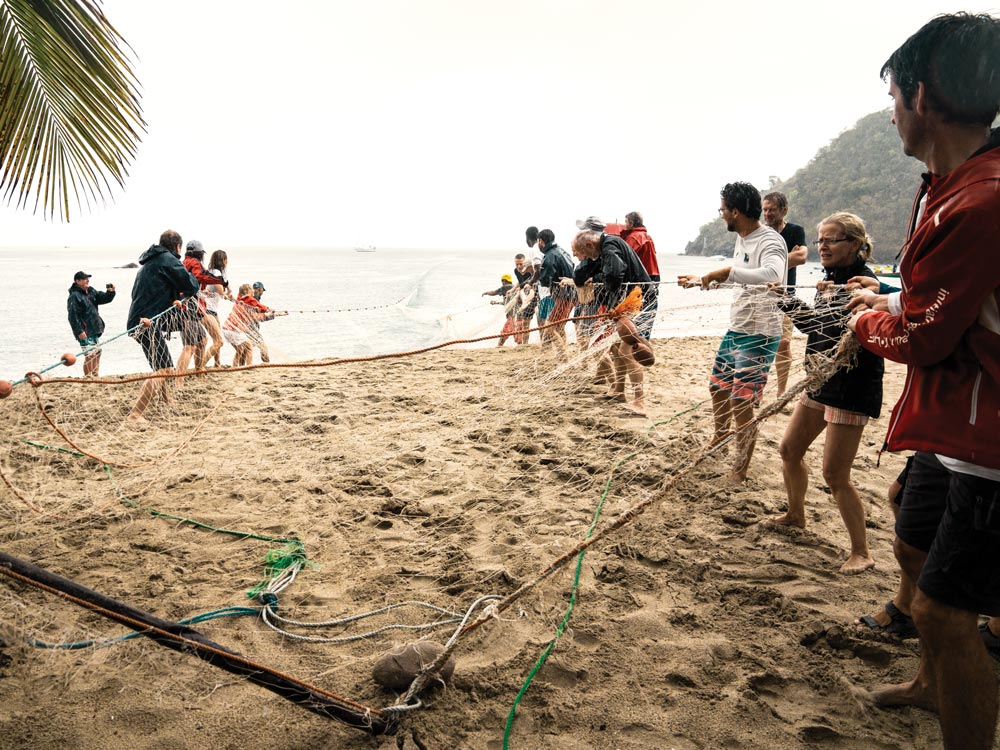
After a spell, Whittle and I wandered off to see the backstreets of town. We found well-kept houses with neat yards, many brightly painted in yellow, blue and other calico colors. Eventually, our wandering led us to the Coco Cafe and a table on the beach under a shady tree. The local specialty was the Coco Punch, a concoction of coconut water and rum that was as soothing as it was delicious.
Back at the boat, we squeezed in a quick swim with the turtles, then motored the short distance around the bold point to Grande Anse, an equally lovely bay and beach where there was plenty of room for the fleet to spread out and anchor.
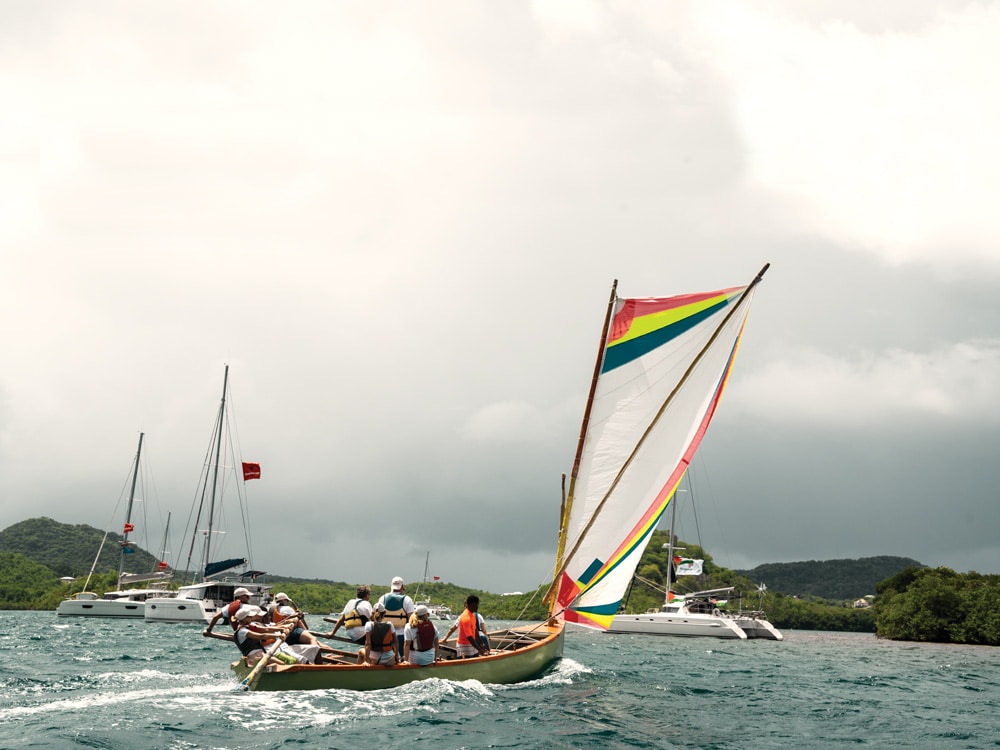
Ashore at Ti Sable, a beachside restaurant with boothlike tables covered by flowing white canopies, the sun had just set and cocktails were being served when all of a sudden there was a commotion. The reception area filled with metallic-colored men and women, some bearing torches, some dressed in ragged outfits, others bare chested. Moving slowly, they struck and held haunting poses, not even blinking, for what seemed like minutes at a time.
And then, like that, they were gone. Whoa, what was that?
In fact, it was les Hommes d’Argile, a local dance troupe that was honestly quite amazing. It was a tough act to follow, but grilled lobsters, local vegetable dishes and music into the evening gave it a good try.
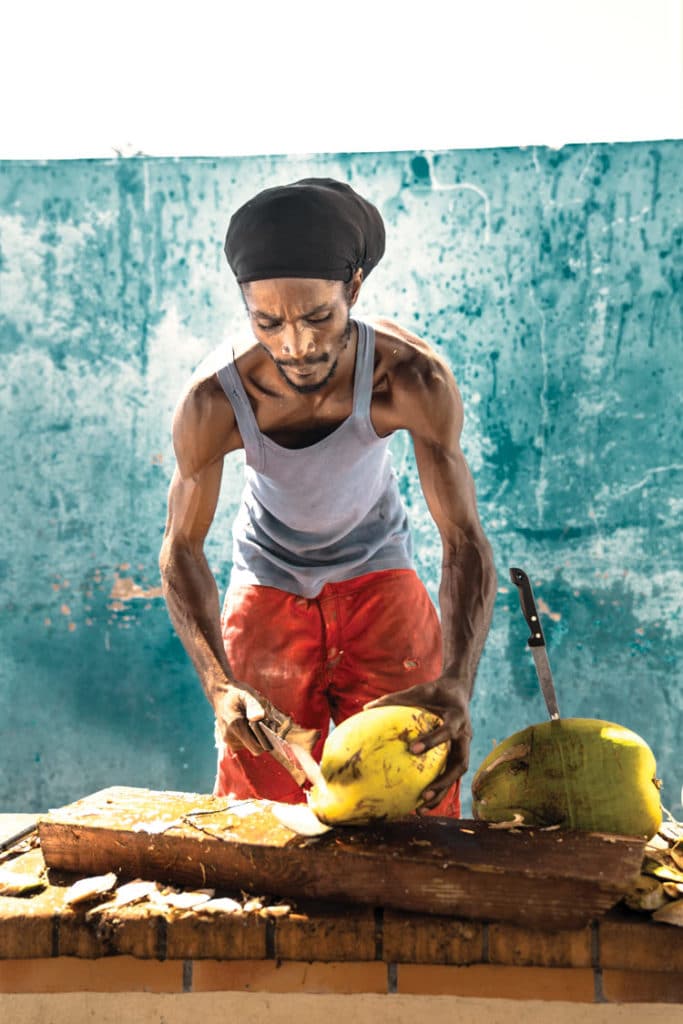
Squalls rolled through overnight. While the rest of the crew slept in, Whittle and I were up at 0545. There was just one other inflatable on the beach when we arrived on shore for the fish-seining adventure, and at first, we wondered if it had been called off. Soon enough, we heard the motor of another dinghy start up, then another. In the end, it was a small but hardy group that set off to help harvest the day’s catch.
After the morning’s adventure, we returned to Guiriden fortified by a pleasant rum buzz and ready for the race back to Le Marin. The breeze was quite light, so we followed the lead of cats leaving before us and motored southward. A half-hour later, though, the VHF radio crackled to life and the race committee announced the breeze was up and the race to the anchorage by Club Med was indeed on. We had five minutes to find the starting line. We scrambled to hoist sail and barely made it in time. The wind, of course, immediately died, just about the time the heavens opened up anew.
As Guiriden approached Diamond Rock, the skies at last cleared and a fresh breeze — on the nose — filled in. We rode a starboard tack toward shore, then tacked out, certain we’d clear the rock.
We didn’t. Instead, we continued on out to sea before tacking again toward shore, certain we’d clear the rock this time.
We didn’t.
Nor did we leave it behind the third, fourth or fifth time. The current that once made the rock an important British military outpost refused to give up its grip on us. To be honest, we were getting pretty sick of the darned rock, and the wind was dying to boot. Under the threat of mutiny, or worse, drunken mutiny, Ted relented, started the engines, and we motored the remainder of the way. To a person, no one wanted to miss the reception, dinner and festivities that night at Club Med.
Sunday was the final day of the rally. In the morning, a powerboat towed three yoles to the beach, where they were pulled ashore by their crews. The yoles are traditional Martinique sailing and fishing skiffs. Each boat was 30-something feet long and rigged with a single mast made from the trunk of a tree and a square sail and gaff. Underway, boards are wedged into the opposite gunnel and the crew hikes out on them to windward. To tack, the boards are reset on the opposite side. Every summer, a fleet of them races around the island in Le Tour de Yoles Ronde Martinique, an eight-stage, 110-mile contest.
On the dock, there were families fishing, and ashore we found a sleepy little town, where the people could not have been friendlier.
Once rigged, each yole had a local captain and carried a dozen or so crew from the rally. It was gusty, and the boats took off like a shot. We chased them in our inflatable/photo boat, but couldn’t keep up, though we did cut them off when they tacked. We even followed along as they cut through a seemingly impenetrable grove of mangroves into an adjacent little bay filled with all manner of craft tied to the shore, and a pirate ship at anchor, complete with a crew who, when they saw us coming, brandished sabers and a cannon. It was quite the little aquatic village.
Back out in fresh breeze, the yoles took off across the bay for one last spray-flying ride before returning to the beach. As the crews derigged the boats, the rally came to its official close. It had been an action-packed few days, and goodbyes were heartfelt. But for Guiriden, there was still some fun to be had.
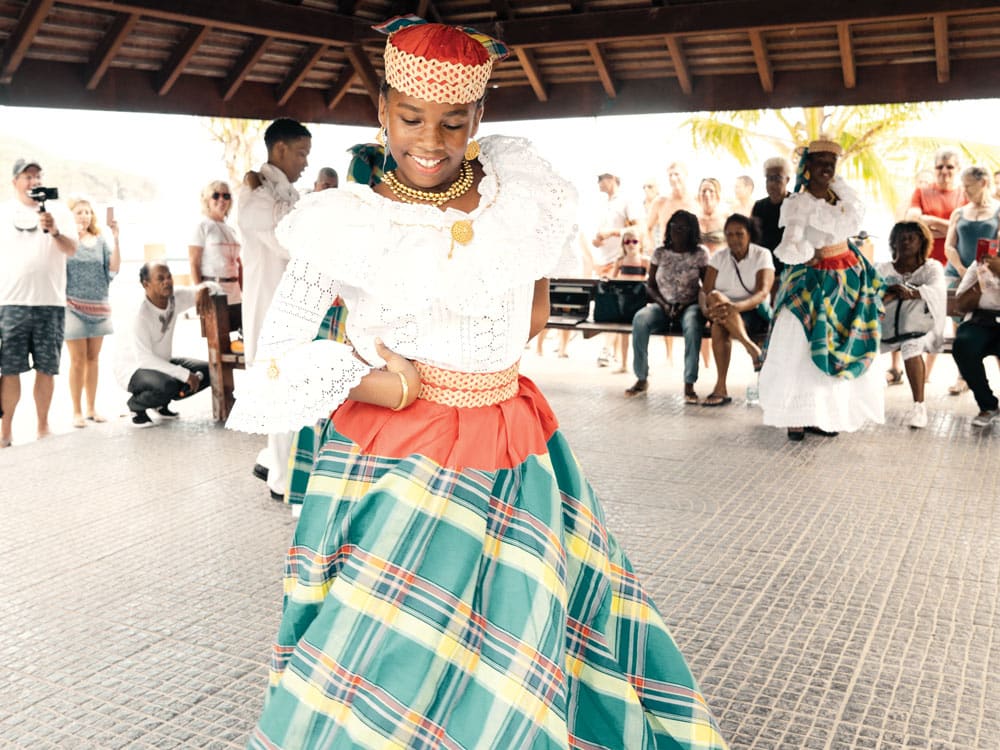
Returning to the marina for a few supplies, we picked up Dan Lockyer, general manager of Dream Yachts in the United States, and then set off northward once again, this time to Anse Mitan, a lovely beach and bay a bit farther north than our travels had taken us previously. We had good wind behind us as we barreled up the coast, first on a run, then a reach and finally closehauled as we headed for the beach, where we anchored in about 20 feet of water. After days of set schedules and bustling activities, a relaxed swim; the sunset over Mount Pelee, Martinique’s towering volcanic peak; and dinner aboard were most welcomed. It was definitely lights out by 2300 for this crew.
Despite a rainy start to Monday morning, we took the dinghy ashore to the nearby public beach and left it tied to a tree. From there, it was a short walk into the village at Trois-Îlets, a popular tourist spot with restaurants, galleries and shops. We explored the town. Then, when a particularly wet and prolonged squall rolled through, we explored Carol’s, a circular bar with wide canvas awnings, a friendly atmosphere and giant mojitos.
By lunch, we were back on the boat with the bows pointed south. Once again, the rain had robbed us of wind, so we gave the batteries a good recharge. By the time we were anchored in Ste. Anne, a small community just south of Le Marin, the sun was out and skies were blue. Whittle and I took one last walkabout ashore. As at Petite Anse d’Arlet, a lovely church stood at the head of the pier. On the dock, there were families fishing, and ashore we found a sleepy little town, where the people could not have been friendlier. When it turned out one shop didn’t sell ice, the proprietor walked us down the street to one that did.
On every charter trip I’ve been lucky enough to go on, there’s been something remarkable about that last night on the boat. Anchored in Ste. Anne, it was the golden hills at sunset, the warm night air, dinner with friends and conversations that went well into the night. It wasn’t just a happy ending, it was perfect.
Mark Pillsbury is CW’s editor.

